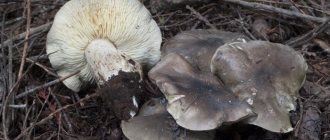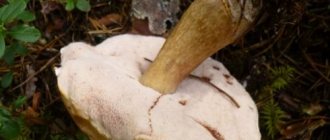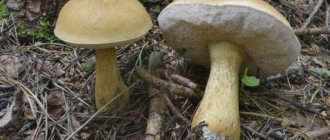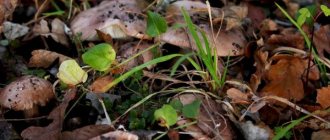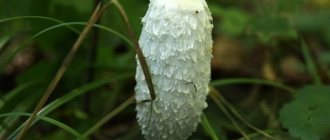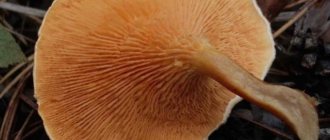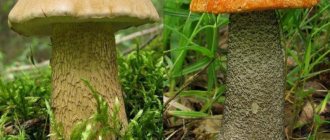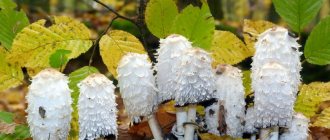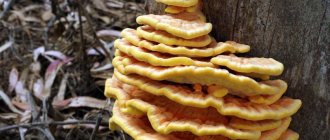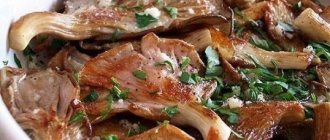Mushrooms
0
1532
Article rating
Kira Stoletova
The spurge mushroom (milkweed) is difficult to find in the country’s forests despite its prevalence. Most often, mushroom pickers mistake it for an inedible species, so they simply pass by.
Description of the spurge mushroom
Description of the mushroom
This species is also known in the literature and among the people under other names:
- the milkman is the best;
- milkweed;
- milk mushroom red-brown;
- smoothie;
- underbaby;
- registry;
- redneck
The milkweed mushroom (Lactarius volemus) belongs to the Russula family, the genus Milky.
Few people put this representative of the mushroom kingdom in their basket, since it is not as well known as, for example, the black milk mushroom or the yellow row. But true connoisseurs of the unique taste of milkweed walk tens of kilometers to find it. A detailed description and special characteristics of this species, and there are many of them, make it possible not to confuse milkweed with other relatives.
What does it look like
The spurge mushroom is quite large in size . Its cap reaches 15 cm in diameter, in rare cases - 20 cm, fleshy, in the early stages - convex, slightly concave in the middle with edges curved towards the stem. Over time, it acquires a prostrate or funnel-shaped shape.
Did you know? In Italy, spurge is considered the most valuable mushroom. Sauces made from it are served in the most expensive restaurants for a lot of money.
The skin is dry to the touch, velvety, and often cracks due to age and lack of moisture. The surface is matte, brown-red, red, red-yellow or light orange, without concentric circles. The center of the hat is always darker than the edges.
The leg of the milkweed is thick, reaches 4 cm in diameter and from 4 cm to 12 cm in height, has the shape of a cylinder, flat or slightly widened in the middle. In young mushrooms it is dense, but with age it becomes hollow and tubular. The surface of the leg is velvety, smooth, pleasant to the touch. The color is the same as the cap, or slightly lighter, which is more common.
The pulp is dense, but fragile, white in color, and darkens when cracked when chapped. Has a sweetish taste. Older mushrooms have a distinct smell of herring, crab or sunflower. When damaged, both the cap and the stem secrete abundantly milky juice, which has a sweetish or resinous-bitter taste.
When exposed to air, the milk darkens to brown and changes consistency, becoming caramel-sticky. The milkweed blades are white with a yellowish or pinkish tint and darken with age. They are often located, have a straight or fork-shaped shape, and slightly descend along the stem.
How to distinguish molokanka from milk mushrooms
The main trouble for a novice mushroom picker is to collect a full basket of pseudo mushrooms, brag to neighbors, spend time preparing, and then shamefully throw the harvest in the trash. Finding them is much easier: experienced “hunters” pass by without paying attention to these mushrooms. So you need to know the special signs that the Molokan woman can boast of. The mushroom really looks like a milk mushroom, but it can still be identified.
Firstly, the milk mushroom is fringed, with concentric zones, and the “fake” is smooth. Secondly, the “milk” secreted by milk mushrooms quickly turns yellow in the air. Violin juice retains its original color. Thirdly, the pulp of molokanka is denser and drier. And the caps of the mushrooms, despite the striking similarity, have slightly different shapes: the edges of the mushrooms are slightly turned down, and the edges of the mushrooms are slightly turned up.
Varieties and lookalikes
An experienced mushroom picker will never confuse the red-brown milk mushroom with anything else, but novice lovers of quiet hunting can still mistake some of its other relatives for it :
- gray-pink milky (Lactarius helvus
) is very similar in appearance, although much paler, moreover, it does not secrete abundantly milky juice on a break or cut, and has a characteristic smell of dry grass without a sweetish tint; - lactiferous hygrophoroid (Lactarius hygrophoroides
) differs from the common sap in that its milky sap does not change color when weathered, and the plates under the hat are located much less frequently; - non-caustic milkweed (Lactarius mitissimus
) does not grow in diameter more than 7 cm, the hat never cracks; - neutral milky (Lactarius quietus
) secretes a yellowish milky sap that does not change color when exposed to air and has no characteristic odor.
Direct salting
So, you have fully prepared molokan mushrooms. How to salt is a separate song, although not too difficult to perform. In the absence of a tub, it is recommended to use an enamel bucket without chips on the inner surface.
Large caps can be cut - purely for ease of use. The mushrooms are layered with halved garlic (about a head will be left), thin circles of horseradish root, lemongrass and black currant leaves, dill seeds (or its umbrellas). Black peppercorns are also acceptable, but not too much. Each layer is sprinkled with a coffee spoon of salt. The top of the bucket is covered with clean gauze, a wide plate and a weight are placed on it - a three-liter bottle of water will be enough. Monitor the condition vigilantly: if mold forms on the gauze, it must be washed. It’s better to replace it with a new one, it’s not that expensive.
Molokankas will be salted from a couple of weeks to a month, depending on the temperature. The warmer the faster, the colder the tastier. It is better to store them cool and eat them like any other salted mushrooms.
Growing
You can grow the spurge mushroom at home under any tree species, but nut plantations provide maximum germination and yield. In addition, such proximity significantly increases the fruiting of crops due to the formation of mycorrhiza.
Milkweed spores can be purchased at the store and sown according to the instructions:
- Mix 15 g of seeds with 0.5 liters of sand or dry soil (per 1 m²).
- Fluff up the soil under the tree, reaching the roots, to a depth of 5–15 cm.
- Distribute the mycelium over the area.
- Cover with garden, or better yet, forest soil, mixed in equal proportions with humus.
- Use a watering can with a fine sprayer to pour 10 liters of water per m².
- Mulch the top with soil and sawdust.
Did you know? Almost two thirds of mushrooms sold on the world market are
artificially grown in China.
You can obtain seed material yourself . To do this, you need to find old mushrooms without washing them, grind them in a meat grinder, add water and leave in a dark, warm place for 2 weeks. After time, the cake on top must be removed, and the remaining liquid will be a solution of milkweed spores.
Next, everything is done in the same way as with purchased material, only the mycelium will be distributed over the area not in dry form, but by watering. A harvest of red-brown milk mushroom can be expected within three months, then fruiting, subject to proper watering, will continue until the end of October.
Recipe No. 4 (in a water bath)
- Lingonberries and sugar. Equal quantities.
- Take two pans of different sizes. Pour water into the large one and place the small one in it.
When the water in the bottom boils, pour berries and sugar into the top. Heat until the sugar dissolves and that’s it. You can eat it right away or pour it into a jar.
Improvise with the amount of sugar, replace it with honey, add various fruits, cranberries and blueberries.
Remember that it is difficult to completely spoil the jam; there is always a way out. If too sweet, add lemon juice. It will also protect the jam from sugaring.
If it becomes moldy, add a glass of sand per 1 kg of berries and digest, constantly skimming off the foam. When the foam stops appearing, turn off the gas and pour into jars.
But now we have returned from Lapland. The five jars of jam I had brought with me suddenly ran out quickly. But the strong desire to gnaw on a piece of toast with delicious sweet and sour berries in the morning or to put a spoonful of lingonberries in cottage cheese remains. The first attempts, consisting of lingonberries and sugar, were similar in taste, but in terms of thickness they categorically did not reach the Finnish ideal.
Salvation came in the form of pectin for quick jam. With him I finally managed to get it thick, beautiful, and sweet exactly as much as I want at the moment. But the recipe on the packets of this miracle remedy is very, very general, and the berries are all different, each requiring a special approach. If you don’t sell pectin, I don’t even know what to recommend. When I can’t buy pectin, I try my best to cook it with quince and apples, but it still turns out a little different.
JAM 500 g lingonberries, 200-300 g sugar, 10 g pectin (meaning, half a pack for 1 kg of berries. If you want, you can cook a whole kilo of lingonberries with a whole pack, just don’t forget that you need twice the sugar more, but that’s too much for me at one time)
Berries for lingonberry jam are equally suitable both fresh and frozen. It doesn’t hurt to sort both of them before cooking to remove pine needles, dry leaves and ant corpses, but defrosting frozen ones is completely unnecessary - they will defrost themselves during cooking.
We sorted it out and weighed it - pour it into a saucepan, sprinkle it with pectin, mix it and put it on the fire to cook. At first you will have to stir quite often, but as soon as the lower berries give juice, the jam will begin to calmly come to a boil, without the risk of burning. No need to add water! The berries will definitely give juice, and we have absolutely no need for excess liquid in the jam.
As soon as the berries boil, you need to note the time and you can add sugar. First add 200 g of sugar, stir and taste after 1 minute. Lingonberries come in different varieties, if you come across ripe and sweet ones, then maybe 200 g will be a little too much. But if it’s sour, there’s nothing you can do, you’ll have to add another 50, and then maybe another 50 g of sugar.
300 g is the maximum I’ve ever poured into lingonberry jam, but I generally like it sour. The pectin package advises taking 500 g of sugar per 500 g of berries. For me, this is clearly too much, but if you like it sweeter, maybe this proportion will seem optimal to you
And besides, it’s important what you need this jam for
Benefits of mushroom
- Red-brown milk mushroom is characterized by a rich chemical composition, which includes:
- volemolide or mushroom estrogen;
- sugar alcohol;
- Volemitol;
- ethanol extract;
- sterol;
- cortisone;
- alimentary fiber;
- ash;
- vitamins B9, B6, B2, D, PP, E;
- trace elements: chromium, rubidium, cobalt, iron, fluorine and selenium, potassium, phosphorus, magnesium, calcium and sodium;
- useful acids: tyrosine, valine, lysine, threonine.
All these enzymes, vitamins and microelements make it possible to use the mushroom for the prevention and control of various diseases.
We recommend that you familiarize yourself with how to distinguish between edible and inedible mushrooms by appearance.
Rubella Lactarius Subdulcis
A mushroom from the same genus Milky, the Russula family, also known as Sweetish Milky.
This mushroom is also smaller (its cap grows only up to 7 cm), and is also similar to the Podoreshnik with its brownish color. What’s interesting is that its juice, at first taste, also tastes sweet, but this sweetness is immediately replaced by a bitter aftertaste. The pulp of the Red Mushroom gives off a slight rubbery smell and is bitter in taste, so it is hardly possible to confuse this mushroom with our hero. Rubella is a conditionally edible mushroom and can be eaten after preliminary boiling.
The Podoreshnik mushroom seems like a special gift from nature to a person who loves to put everything into his mouth at once. It looks like a juicy forest caramel - cut it off, wipe it with a clean cloth - and you can immediately and with pleasure gnaw on it while searching for other mushrooms. But, in order to avoid troubles, first make sure that this is really the same forest milk miracle.
Use in cooking
For culinary purposes, it is better to use young mushrooms, since the older the mushroom, the more expressive the specific smell, which also intensifies during the cooking process.
Euphorbia belongs to the fourth taste category, so boiling and frying them is not recommended , although some mushroom pickers speak of fried euphorbia as a unique delicacy. Cold pickling allows you to preserve the maximum benefits of mushrooms and get a wonderful crispy snack for the whole winter.
Important! The red-brown breast is never affected by worms and insects. It does not need to be soaked before cooking.
The recipe is extremely simple:
- Rinse the mushrooms under running water.
- Separate the legs from the caps - this way they will fit compactly and correctly.
- Place milk mushrooms in layers in a wooden, ceramic or enamel container, sprinkling with coarse salt at the rate of 50 g of salt per 1 kg of mushrooms.
- Cover with gauze in 3-4 layers, place a wooden circle on top that fits the inner diameter of the container (you can use a plate or an enamel lid).
- Place the pan or barrel in a cold place for pickling for 1 month. During this time, the circle and gauze will need to be washed daily.
- A month has passed - take out the mushrooms and enjoy the unique taste.
Milkman
Red-brown breast milk (Lactarius volemus)
Milkman
Spurge
Lactarius volumemus (Fr.) Fr., Epicr. syst. mycol. (Upsaliae): 344 (1838)
Description
The cap is 5-17 (up to 16) cm in diameter, convex in youth, then spread out, possibly depressed in the center, and even concave. The edge of the cap is straight, thin, sharp, at first tucked in, then straightens and even rises. The color is reddish-brown, brownish-brown, in rare cases rusty or light ocher. The surface is first velvety, then smooth and dry. Often cracked, especially in drought. There is no zonal coloration.
Application in medicine
The spurge mushroom has a large number of beneficial properties, due to which it is widely used in folk medicine. The most valuable is the milky juice, which has a powerful antitumor effect.
Fresh mushrooms contain an ethanol extract, which is often used in the fight against various malignant tumors, including cancer. The presence of cortisone in tissues allows it to be used in products to combat inflammation and rheumatism.
Milkweed tincture is taken 1 tsp. 3 times a day for varicose veins, hemorrhoids, gout, otitis media, bronchitis, fever, sore throat, gastrointestinal diseases and inflammatory processes.
When you have a runny nose, lubricate the nasal mucosa with an oil composition. External use of the tincture helps solve problems of skin inflammation, cure burns, allergic rashes, etc.
- In addition, the red-brown milk mushroom performs a number of other functions:
- blocks the spread and removes bad cholesterol;
- has an antioxidant effect;
- helps restore the microflora of the digestive tract;
- Helps replenish proteins and proteins in a healthy diet.
Recipe for milkweed mushroom tincture in oil
To prepare a milkweed tincture in oil, the mushrooms must first be dried. To do this, they are cut into 1 cm thick plates and hung in shaded, well-ventilated places. You can also use an electric dryer.
Important! Before use, the tincture should be shaken thoroughly until smooth.
After the raw material has completely dried, it is ground into powder with a coffee grinder or blender and poured with linseed or olive oil at the rate of 0.5 liters of oil per 3 tbsp. l. mushroom powder. The container is tightly closed and left to infuse in a warm, dark place for two weeks. There is no need to strain the composition. It can be stored in the refrigerator for several years.
Proper preparation is a guarantee of success
To make frozen lingonberry jam the best it can be, you need to know some rules. They will help you get the maximum benefit from the berries.
Remember:
- Use only ripe berries. Green and overripe fruits will only spoil the taste.
- Remove rotten berries immediately. They will significantly reduce the shelf life of the finished dish, especially when it comes to recipes without heat treatment.
- Take the trouble to thoroughly rinse and peel the berries. Fill the preparations with cold water so that the liquid completely covers the berries. Drain the water along with any floating debris. Then drain the lingonberries in a colander and let the liquid drain.
- In an aluminum container, the jam will quickly oxidize and acquire an unpleasant taste. Use better enamel containers.
You can learn more about how to make preparations correctly, as well as what else can be prepared from soaked lingonberries. And I’ll move on to the most important part of my story - proven recipes for delicious jam from sweet and sour lingonberries.
What is the danger of the mushroom
The rich chemical composition not only helps fight diseases, but is the reason for the presence of a number of contraindications and warnings regarding its use. The spurge mushroom should not be consumed by pregnant women, children under 7 years of age, or breastfeeding mothers.
- In case of intolerance to one or more components of the mushroom, side effects may occur:
- skin itching;
- atopic dermatitis;
- gastrointestinal disorder;
- allergic rhinitis or ARVI;
- a sharp increase in temperature;
- headache;
- cough, shortness of breath.
People suffering from kidney disease, cholelithiasis, gastritis and gastric ulcers in an acute form should take medicines based on milkweed with extreme caution. Hypertensive patients are not recommended to consume more than 1 tsp. infusion per day. The mushroom has a stimulating effect on the nervous system, so it should not be eaten in any form later than three hours before bedtime.
Red-brown breast milk is a tasty and healthy product, but it is extremely difficult to find. Often, in search of a few mushrooms, you have to walk tens of kilometers through swampy areas, but believe me, they are worth the effort.
To soak or not?
The debate about whether or not it is necessary to soak the pine tree in water before use continues to this day. Many people do not like the specific “herring” smell of this mushroom, and they soak it in water for 2 days. However, it should be taken into account that soaking does not always help get rid of the smell. You can boil the mushrooms in salt water for 20 minutes - this usually helps get rid of the smell.
However, as already mentioned, many lovers eat Podashnik generally raw, without experiencing any discomfort, so this is more a matter of taste and habit.
After harvesting, fresh fruiting bodies should be stored in the refrigerator for no longer than 15 hours. After this period, they begin to deteriorate.
Purple miracle amethyst lacquer
At the end of summer, in the forests, in damp meadows, amethyst varnish (also known as purple) grows - small mushrooms on a thin stalk with an outstretched cap. The mushroom body is completely painted in lilac-violet color, even the plates under the cap, which smoothly descend to the stem, the only thing is that in old specimens they fade. The edible tender pulp is also purple, with a pleasant taste and smell.
The poisonous mushroom Mycena purea is very similar to old lacquer mushrooms. You can distinguish it by the characteristic unpleasant smell of radish and the plates of pure white color (in the amethyst varnish they are slightly purple).
